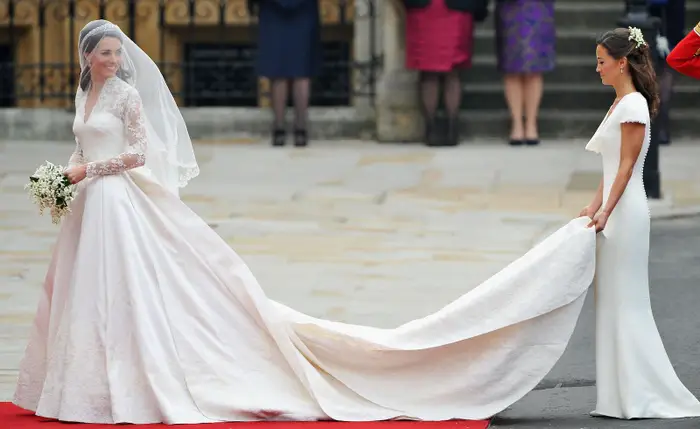Weddings are more than just formalities; they are also cultural celebrations of love and the culmination of a couple’s journeys. The bride’s clothing stands out as a representation of class and tradition among the many other elements that contribute to weddings being memorable. Wedding gowns have changed throughout the years to reflect shifting social mores and fashion trends. One feature has astonishingly kept the same: the continued appeal of white wedding gowns.
Historical Development
When Queen Victoria of England married Prince Albert in 1840 while donning a white silk-satin gown. The idea of the white wedding dress first emerged in the 19th century. This significant decision gave rise to a fashion fad that would become viral. Before this, brides wore a variety of colored dresses, selecting their nicest or most expensive garment regardless of its color. Queen Victoria’s decision constituted a dramatic break from this custom. The link of her attire with innocence and purity started to influence public perception.
Meaning and Symbolism
The white bridal gown has come to represent innocence, purity, and fresh starts. This symbolism has been passed down through the years and is firmly ingrained in many different cultures. Although the meaning of purity has changed over time, the white dress continues to represent the idea of beginning again and moving into a new stage of life with hope and promise. The sentiment it conveys, not just the hue, is what continues to ring true.
Cultural Differences
White wedding gowns have come to be seen as a universal symbol, different cultures have their takes on bridal wear. Vibrant colors are still chosen in several countries for weddings; they stand for happiness, prosperity, and cultural history. White wedding dresses, however, have found a home in various cultures as well, being accepted as a second wardrobe or as a blend of traditional and modern aspects.
Present-day Interpretations
Although many people still have a particular place in their hearts for the traditional white wedding dress, contemporary versions have started to surface, reflecting the shifting dynamics of society. Instead of following convention, brides are increasingly looking for gowns that complement their styles. As a result, unorthodox styles, alternate hues, and even pantsuits or jumpsuits have begun to replace the formal gown. Designers are now providing a wide variety of alternatives that cater to varying interests while maintaining the timeless appeal of the white wedding dress.
Contrary to Stereotypes
White wedding gowns have received a lot of flak for maintaining sexist gender stereotypes and unattainable beauty standards. However, there has been a change in recent years as awareness of diversity, body positivity, and gender-neutral clothing has grown. Wedding clothing is becoming more inclusive and representative of contemporary culture as designers respond by developing outfits that accommodate a greater range of body types and gender expressions.
Environment-Related Issues
The wedding business has come under investigation for its ecological impact in a time of increased environmental awareness. This has led some brides to look for environmentally friendly solutions for their wedding dresses. As couples look to match their weddings with their principles, vintage dresses, repurposed fabrics, and ethically made gowns are becoming more and more fashionable. These decisions are changing how we view wedding dresses by highlighting their timeless beauty in a more environmentally friendly perspective.
Tradition-keeping in the Modern World
The blending of cultures and the sharing of traditions occur as the world becomes more linked. Despite this, throughout all cultures and regions, the white wedding gown has managed to retain its attractiveness and significance. The universal symbolism of hope, purity, and new beginnings at the heart of this tradition lends it versatility.
Every stitch embodies eternal elegance.
Few wedding apparel items are as recognizable and classic as the traditional white wedding dress. For decades, Western society has upheld the timeless custom of wearing a white gown on one’s wedding day as a representation of innocence, purity, and new beginnings. The fascination of white wedding gowns extends beyond simple design; it is rooted in a deep cultural meaning.
Historic importance
After Queen Victoria decided to wear a white bridal dress during her nuptials to Prince Albert in 1840, the tradition became widely accepted. Brides wore clothes of many hues before that, but Queen Victoria’s decision started a new fashion that is still popular today. Many brides adopted this custom to symbolize the beginning of their lifelong journey with their partners because the white dress grew to be associated with purity and marital bliss.
Beyond Symbolism
White is the ideal color for wedding dresses since it is frequently linked to brightness, goodness, and innocence. It stands for a new beginning and a new chapter in the couple’s lives. White wedding gowns accentuate the enchanted and romantic mood of the wedding day. The bride might easily become the center of attention thanks to the effortless elegance of a white gown.
Different Styles
The world of wedding dresses offers a varied selection of styles to suit every bride’s taste despite the ongoing tradition of wearing white. White wedding gowns can range from grandiose ball gowns to sleek mermaid forms.
Cultural Translation
Although they have their origins in Western culture, white wedding gowns have become universal over time. Today, numerous brides from all around the world appreciate the elegance of white gowns and incorporate them into their customs. The intercultural mingling here emphasizes the universality of love and the significance of the white wedding gown.
Conclusion
A sign of love, optimism, and the exhilaration of starting a new adventure, the white wedding dress is more than just a piece of clothing. It is a mirror of the human experience. The white wedding dress has endured the waves of shifting fashion and societal standards from its 19th-century roots to its contemporary interpretations. It is emerging as a timeless and unifying symbol of beauty. The attractiveness of the white wedding dress will undoubtedly continue to capture people’s attention in the future as it serves as a reminder of the beauty of accepting fresh beginnings.

